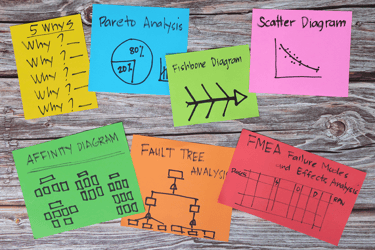The Packaging Industry's Sustainability Challenge: Why ERP Systems Are Essential for Success A straightforward guide to navigating sustainability regulations across folding carton, flexible...
Transforming data into gold: the alchemy of actionable insights
In the era of digitized clicks, interactions, and transactions, data has become the lifeblood of modern enterprises.
However, with the volume of data exponentially growing every day, getting valuable insights that managers can act on is increasingly challenging.
The good news is that there are tools that can quickly turn lots of data into information, creating actionable insights. Actionable insights are especially effective in bolstering team performance, customer satisfaction, or strategic objectives.
This article examines how abundant data from packaging manufacturers metamorphoses into gold (actionable insights) that drive business success.
Contents
Understanding actionable insights: is it AI/ML?
Actionable insights emerge as meticulously crafted conclusions derived from in-depth data analysis. Unlike mere aggregates of raw data, they provide a crystal-clear pathway for informed business decision-making, enriched by evocative visualizations and grounded in predictive analytics.
Actionable insights dissect the complex web of patterns and relationships embedded within data sets, offering practical, evidence-based recommendations tailored to data analysts and strategic business units. These insights empower packaging manufacturers to pinpoint and resolve operational challenges while capitalizing on emerging market opportunities. They adeptly navigate the rapidly shifting competitive terrains by integrating discrete and continuous data streams. This fusion yields a holistic view of the levers influencing internal efficiencies and the broader market forces, setting them apart from the outputs of Artificial Intelligence (AI) and Machine Learning (ML) systems.
In contrast, AI/ML technologies focus on automating data analysis, learning from data patterns to make predictions or decisions without explicit programming for each task. While AI/ML can be part of the strategy to uncover patterns that may provide insights, creating actionable insights involves additional steps. This includes the integration of AI/ML findings with domain expertise, strategic context, and a nuanced understanding of business goals to formulate actionable recommendations. Thus, while AI/ML lays the foundation by processing and analyzing vast datasets, deriving actionable insights requires a deliberate synthesis of technology, human judgment, and strategic business understanding.
Crafting actionable insights from data
Turning data into actionable insights isn't alchemy but a structured approach every packaging manufacturer can implement. Here’s how companies can demystify the process and make data work in their favor:
-
Set clear objectives
The quality of insights derived from data is crucially linked to the clarity and specificity of its business goals. For a packaging manufacturer, data becomes significantly valuable when it's meticulously aligned with strategic objectives, such as enhancing production efficiency, reducing waste, increasing sales, or improving client satisfaction.
For instance, analyzing customer feedback or return rates is instrumental in refining product quality or adapting packaging solutions to meet market demands better. This focused analysis can lead to innovations in packaging design, materials, and processes that boost sales and enhance customer loyalty.
Similarly, if the goal is to optimize operational efficiency or ensure workplace safety, data concerning machine performance, energy consumption, or incident reports must be scrutinized with those aims in mind. This ensures operational adjustments and investments directly contribute to tangible improvements in production line efficiency, energy use reduction, or a safer work environment.
A packaging manufacturer can elevate raw data into actionable insights by strategically aligning data analysis with clear, measurable goals and steering informed decisions across production efficiency, innovation, customer satisfaction, and safety. This goal-focused approach positions data as a key strategic asset, driving tangible improvements and ensuring every piece of analyzed data directly supports achieving defined objectives, turning information into a powerful tool for strategic advancement. -
Equip with the right tools
Transforming data into actionable insights requires businesses to refine their technological infrastructure, emphasizing not just speed but the relevance and quality of the insights generated. This journey begins with a critical assessment of the current tech stack, identifying tools that genuinely contribute to the analytical process and eliminating those that complicate it without adding value. Such technological decluttering paves the way for a more streamlined, efficient suite of tools that work harmoniously, minimizing friction and maximizing data utility.
Automation is pivotal in this optimized ecosystem. By taking over routine data collection and analysis tasks, automation significantly enhances efficiency. This strategic move conserves valuable human resources for higher-level interpretative work and strategic planning and ensures a smoother, error-minimized data flow from collection to insight generation. Adopting scalable solutions further fortifies this infrastructure, providing flexible, cost-effective options that grow with the business and promote a collaborative, silo-free environment.
At the heart of this refined tech stack are advanced analytics platforms, which utilize vast computing resources to delve deeper into data than ever before. These platforms democratize access to sophisticated analytics, empowering businesses of all sizes to derive profound insights and compete more effectively in their markets.
By adopting this strategic approach to technology, businesses create a direct, unobstructed path from raw data to valuable insights. The result is a responsive, agile tech ecosystem that facilitates timely and cost-efficient insight generation and aligns perfectly with the organization's strategic goals. Every piece of data analyzed contributes to informed decision-making and strategic success. -
Contextualize your data
Data gains value not upon collection but through comprehension. Without context, it's merely a perplexing array of figures; with context, it transforms into actionable intelligence. This transformation involves analyzing the 'why' behind data and integrating it with narrative depth to reveal its real-world implications.
Contextualization correlates data with external factors, turning raw numbers into insights. For instance, a drop in sales becomes significant when viewed against market trends or competitors' actions, offering a strategic direction.
This approach lays the groundwork for predictive analytics, enabling leaders to interpret underlying trends and make informed decisions. It combines qualitative and quantitative analysis, considering industry dynamics, consumer behavior, and technological shifts, aligning team efforts with company strategies.
By thoroughly contextualizing data, businesses can move beyond superficial analysis and ensure that every piece of information serves as a strategic asset. This prevents misinterpretation and enhances strategic decision-making across all organizational levels, turning data collection into a cultivation of knowledge. -
Embrace visualization
The saying "a picture is worth a thousand words" holds especially true for data presentation. In today's data-saturated business environment, making complex information easily understandable is not just beneficial; it's essential. Visualization translates the complex language of data into clear, intuitive visuals, enabling swift and confident action.
The process begins with centralization, merging varied data streams into a single, consistent source. This unified data is then ready for visualization, where the challenge is to create simple yet informative visuals that highlight trends and metrics without overwhelming the viewer. This involves using design elements to direct attention to the most critical information.
Real-time visualization further enhances decision-making by providing the most current data view and allowing immediate responses to new insights. This approach speeds up decision-making and maximizes data's impact, as changes can be monitored and acted upon as they happen.
Designing these visuals with the end-user in mind ensures they are appealing and functional, supporting informed decisions. In the fast-paced business world, quickly understanding and acting on data is invaluable, making effective visualization a critical bridge from data collection to strategic action. -
Gamify the experience
Gamification transforms data engagement by making numbers exciting and challenging, turning passive analysis into active participation. It reimagines data as a game, with scores to beat and milestones to achieve, using game-design elements to stimulate competition and improvement.
This approach motivates and embeds accountability and ownership in data tasks. Gamification makes each team member a vested player, encouraging deeper commitment and proactive problem-solving. It also personalizes the data experience, allowing individuals to track progress and take pride in their achievements, making data tangible and impactful.
Aligning gamification with organizational culture is crucial. When properly implemented, it boosts data literacy, engaging employees in understanding and leveraging data more effectively. Gamification thus turns data into a collective playground for innovation, driven by the universal appeal of games and achievements. -
Dialogue and adaptation
Turning data into actionable insights is a collaborative process that relies on open dialogue, shared interpretation, and united action. Insights spark discussions, drawing on diverse perspectives to explore data's full potential.
The key to this process is making data transparent and accessible across the organization. This ensures everyone, from frontline staff to executives, can engage with and understand the data. Tools like intuitive dashboards enhance this accessibility, simplifying complex information into actionable insights.
Collaborative analysis of data drives strategic decision-making, with team discussions bringing varied expertise to bear on the insights generated. This collective approach not only aids in adapting to industry changes swiftly but also fosters a culture of innovation and data-driven experimentation.
In essence, valuing and sharing insights across an organization catalyzes a culture of collaboration and rapid adaptation, demonstrating that a unified effort unlocks data insights' actual value.
Conclusion
The digital landscape is awash with data, but packaging manufacturers who master transforming this data into actionable insights will lead the charge toward business excellence. By employing these strategies, packaging organizations can organize, structure, and present their data effectively, guiding their teams toward a future packaged in success.



